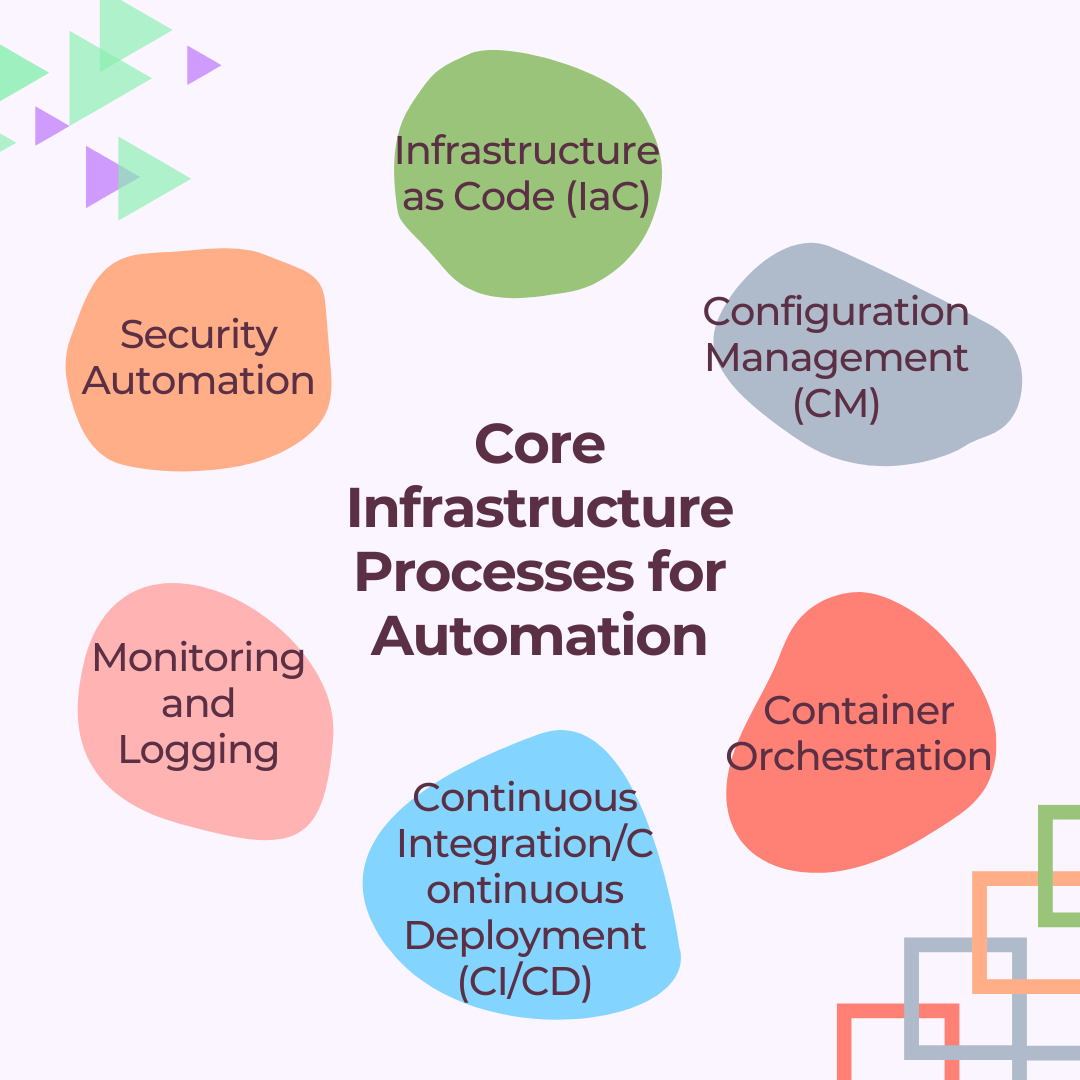Introduction
Handling IT infrastructure manually is inefficient, prone to mistakes, and restricts growth potential. As organizations grow, these inefficiencies can lead to significant delays, increased costs, and system unreliability.
Automating infrastructure processes addresses these challenges by streamlining operations, enhancing consistency, and enabling rapid scalability. This article explores the key infrastructure processes that can be automated to help your organization boost efficiency and remain competitive in today’s fast-paced digital landscape.
What is Infrastructure Automation?
Infrastructure automation involves using software tools and scripts to streamline the provisioning, management, and scaling of IT infrastructure. Instead of manually configuring servers, networks, and storage, automation allows these tasks to be handled through code, significantly reducing errors and improving consistency.
By adopting Infrastructure as Code (IaC), organizations can define infrastructure configurations in version-controlled files, ensuring repeatability. Configuration management tools like Ansible or Chef further ensure that these configurations remain consistent across all environments.
Automation extends to container orchestration with tools like Kubernetes, which manage microservices at scale, and Continuous Integration/Continuous Deployment (CI/CD) pipelines, which streamline the deployment process, ensuring quicker and more reliable software releases.
The benefits of infrastructure automation are clear: it increases reliability, scalability, and cost-effectiveness, making it a critical component in modern IT strategies.
Core Infrastructure Processes for Automation
Automating core infrastructure processes is crucial for improving efficiency, scalability, and reliability. The following are the main areas to prioritize:
- Infrastructure as Code (IaC): Tools like Terraform and Pulumi enable you to define infrastructure in code, ensuring repeatability and reducing errors.
- Configuration Management (CM): Tools such as Ansible and Chef automate the configuration of servers, ensuring consistency across environments.
- Container Orchestration: Kubernetes automates the management of microservices and containers, optimizing resource use and scalability.
- Continuous Integration/Continuous Deployment (CI/CD): Automate the software development pipeline, enabling faster, more reliable releases.
- Monitoring and Logging: Automate monitoring with tools like Prometheus to maintain visibility and control over infrastructure.
- Security Automation: Implement automated security measures, such as role-based access control, to ensure compliance and protect systems.

Challenges in Infrastructure Automation
While infrastructure automation offers numerous benefits, it also presents several challenges:
- Tool Selection: Choosing the right automation tools is crucial but can be overwhelming due to the variety of options available. Each tool has different strengths and may not fit all needs, making careful evaluation essential.
- Skills Gap: Implementing automation requires specialized knowledge. Upskilling or hiring experienced professionals is necessary, which can be time-consuming and costly.
- Cultural Shifts: Adopting a DevOps mindset is crucial for successful automation. However, transitioning from traditional IT practices to a collaborative, automation-driven culture can be challenging.
- Budget Considerations: Although automation leads to long-term savings, initial implementation costs—such as purchasing tools and training staff—can be significant.
How Infrastructure Automation Works
Infrastructure automation streamlines IT operations through a series of automated processes. It typically starts with infrastructure provisioning, where tools like Terraform or CloudFormation set up the environment based on code definitions. Next is configuration management, using tools like Ansible or Chef to ensure all systems are uniformly configured.
Continuous Integration (CI) follows, automating code integration, testing, and validation, which leads into Continuous Deployment (CD), where code changes are automatically deployed to production. Finally, continuous monitoring ensures the infrastructure remains stable, secure, and efficient, using tools like Prometheus or Grafana.
This seamless integration of automated steps enables organizations to manage complex infrastructures with increased efficiency and minimal human intervention.
Advanced Automation Strategies
Advanced automation strategies take infrastructure management to the next level, particularly in complex environments. Integrating automation across hybrid and multi-cloud environments ensures seamless operations and resource optimization across diverse platforms.
Leveraging AI/ML for predictive infrastructure management allows for intelligent decision-making and proactive issue resolution, enhancing system reliability.
Another critical area is disaster recovery automation, where automated failover systems and data backups ensure minimal downtime during outages. These strategies not only improve efficiency but also enhance resilience, making them essential for modern IT infrastructures.
Infrastructure Automation Tools
Choosing the right infrastructure automation tools is crucial for efficient IT operations. Here’s a breakdown by category:
- Infrastructure as Code (IaC): Tools like Terraform and Pulumi allow infrastructure to be defined and managed through code, enhancing repeatability and reducing errors.
- Configuration Management (CM): Tools like Ansible, Chef, and Puppet automate the consistent setup and management of servers and applications across environments.
- Continuous Integration/Continuous Deployment (CI/CD): Jenkins, GitLab CI, and CircleCI automate the integration, testing, and deployment of code changes, ensuring faster and more reliable releases.
- Monitoring and Logging: Prometheus, Grafana, and ELK Stack provide continuous monitoring, alerting, and logging, ensuring visibility and control over infrastructure performance.
Key Takeaways
- Infrastructure automation streamlines key processes, improving efficiency, ensuring consistency, and enhancing scalability.
- Core processes for automation include Infrastructure as Code (IaC), configuration management, container orchestration, CI/CD, and security.
- Challenges include tool selection, skills gaps, cultural shifts, and initial costs.
- Advanced strategies like multi-cloud automation and AI-driven management further optimize infrastructure.
- Choosing the right tools for your needs is crucial to successfully implementing automation across your IT environment.
Conclusion
Infrastructure automation is essential for modern IT, offering enhanced reliability, scalability, and efficiency over manual processes. By automating tasks like provisioning, configuration management, and deployment, organizations can minimize errors, accelerate deployment, and ensure consistency.
Start with core processes and use tools like Terraform, Ansible, and Kubernetes. Begin with small projects to build experience and scale gradually. Address challenges such as tool selection, skill gaps, and cultural shifts.
Leverage advanced strategies like AI-driven management and disaster recovery automation. Embrace automation to transform your IT operations, making them more agile, reliable, and future-ready.

